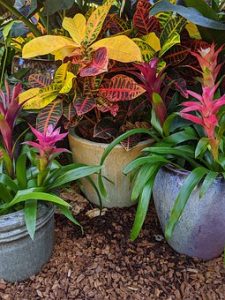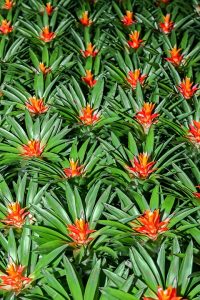 Bromeliads are gaining popularity in the houseplant market, with good reason. They are stunningly beautiful, require limited care, and are quite different than any other plant with a spiral arrangement of leaves (sometimes called rosettes) and spikes of brightly colored bracts. Grown for their unique foliage, these amazing plants make a good addition to most homes.
Bromeliads are gaining popularity in the houseplant market, with good reason. They are stunningly beautiful, require limited care, and are quite different than any other plant with a spiral arrangement of leaves (sometimes called rosettes) and spikes of brightly colored bracts. Grown for their unique foliage, these amazing plants make a good addition to most homes.
Bromeliads are native to tropical North and South America, so they will not survive outdoors in Wisconsin. However, during the summer, they can be temporarily moved outside to take advantage of high humidity and natural rainfall. There are over 3000 species of bromeliads, with several thousand hybrids and cultivars. Columbus became responsible for the spread and cultivation of bromeliads when he transported the only fruiting, edible bromeliad—pineapple—to Spain upon return from his second voyage to the New World in 1493. It took at bit more time for the ornamental bromeliads, but they began to be cultivated in the 18th century.
Bromeliads range in size from one inch to over thirty-five feet tall. About half grow like most plants, with their roots in the soil. Epiphytes (or “air plants”) grow on rocks, other plants or hosts, usually trees, but are not parasitic. They get their nutrients from the air around them. The function of their roots is for anchoring the plant and the uptake of nutrients and water is handled by the leaves.
 Bromeliads will survive, but not thrive, under less than ideal conditions. To make sure yours thrives provide adequate light, humidity, and proper temperature, in addition to keeping them potted, watered, and fertilized correctly.
Bromeliads will survive, but not thrive, under less than ideal conditions. To make sure yours thrives provide adequate light, humidity, and proper temperature, in addition to keeping them potted, watered, and fertilized correctly.
Bromeliads vary in their light needs depending on the type. However, most need as much bright light as you can provide without burning them. Let the plant be your guide: if it is yellowish or pale green, the light level is too high, while dark green, droopy leaves indicate the light levels are too low. Artificial lights are a good option to get the 12 hours of light most plants need. Hang the lights about 8 inches above the top of the plants.
Keep the temperature up to at least 70 degrees during the day and 55-60 at night. The plants will appreciate the humidity on the higher side as well. Keeping it around 50% will benefit your bromeliad.
An actively growing bromeliad can be lightly fertilized. Use a general purpose, soluble fertilizer every 1 to 2 months, but mix the fertilizer in water at 1/3 to 1/2 of the recommended dosage. Do not fertilize during the inactive winter months.
A common problem with bromeliads is overwatering. Most bromeliad houseplants are tank bromeliads, meaning that they have leaves that form a reservoir that naturally holds water. The easiest way to water is simply to fill this reservoir weekly, preferably with rain water, but unsoftened tap water will do. Alternately, you can water at soil level, but do not water until the soil is dry and make sure the soil drains well.
Bromeliads will slowly die over the period of a year or so. The good news is that they freely produce pups (young) at the base of the mother plant. Simply separate the pups when they are about 1/3 the size of the mother, transplant to a new pot, and begin your venture with entirely new plants.
Carol Shirk
Certified Master Gardener




